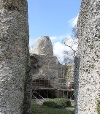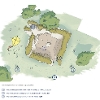Walden Castle
The ruined remains of Walden Castle are one of the most prominent features in Saffron Walden.

Built between 1141 and 1143 it was one of several castles used by Geoffrey de Mandeville to reinforce his power across the region.
The building is Grade I listed by Historic England and is also a Scheduled Monument. Saffron Walden Castle is the remains of a twelfth century tower-keep and located upon the Bury Hill Scheduled Monument, within the Saffron Walden Conservation Area. The castle is an important remnant of the town's history and a well-documented example of a motte and bailey castle with important archaeological remains.
Visiting
You can find Walden Castle in the grounds next to Saffron Walden Museum. The nearest parking is at the Common short-stay car park or, if you are visiting the museum, there is a limited amount of parking in the grounds.
Find Walden Castle on a Google map.
Opening times
The grounds are open at any reasonable time. The inside of the castle keep is closed but you can still walk around the grounds outside of the walls.
Restoration
The Saffron Walden Conservation Area Appraisal for 2012 proposed management actions for the conservation of Walden Castle in Saffron Walden. The structure was also listed on Historic England's Heritage at Risk Register.
Urgent repair work was needed to stop unpredictable falls of masonry and the loss of important medieval fabric from the castle.
Restoration work, following an Outline Masterplan (PDF, 5 MB), was carried out between 2013 and 2021. This was made possible by grant funding of £410,000 from Historic England and funding of almost £450,000 from us.
The flint-rubble walls of the castle keep have now been stabilised and a soft capping has been introduced to prevent further deterioration. New gates have been installed around the historic structure and a new floor finish laid within the ruins of the keep.
Visitors are now able to safely explore this important landmark of Saffron Walden's medieval heritage. At night, a new lighting system dramatically highlights the castle's prominent position on the historic town skyline.

History of the castle
Walden Castle is Grade I listed and a Scheduled Ancient Monument. It comprises the substantial ruined walls of a Norman keep. The Castle ruins are a prominent visual and historical feature standing on high ground at the heart of the historically significant market town of Saffron Walden.
The ruins visible on the site today would have formed part of the basement and first storey of the once 3-storey castle keep. Inside are traces of a circular staircase, a well shaft and a fireplace. It was a tower keep, built on the ground where the solid chalk bedrock could take the weight of the masonry. The round tower to the north of the keep is an 18th century addition.
The castle's fortunes highlight fluctuations in political and monarchical power during medieval times.
Little is known of the origins of the Keep. It is thought to have been built in the late 11th or early 12th century but the builder is unknown. The earliest known reference to it is in 1141, when it was in the ownership of Geoffrey de Mandeville II. In 1143, de Mandeville was forced to surrender the newly built Castle to King Stephen but regained its ownership in 1156, only for the castle to be partly destroyed by order of Henry II around 1158.
The castle was later owned by Maud, wife of Henry de Bohun, Earl of Essex and Hereford. On her death in 1236, the castle passed to her son Humphrey, who became 7th Earl of Essex.
In 1346, Humphrey was given a licence to rebuild and crenellate the castle, adding battlements to the structure. The family had opposed Edward III so in 1362 the castle was confiscated and endowed to the Duchy of Lancaster, later passing into the ownership of Henry IV and remaining a royal manor until the reign of Henry VIII. The manor was given to Lord Chancellor Thomas Audley in 1538 and then passed by marriage to the Howard family.

Much of the stone was removed before or during the 18th century. The turret on the top of the keep was added in 1796 by Lord Howard de Walden. In 1797 the castle passed to Richard Aldworth Neville of Audley End and remained in his family until 1979 when the castle was acquired by Uttlesford District Council.
The layout of the streets surrounding Walden Castle reflects the original line of the castle's inner bailey: Castle Street, Museum Street and Church Street on the west and on the east side it would have followed the old road, a little to the east of the present Common Hill.
Excavations carried out in 1911-1913 confirmed the location of the castle ditch surrounding the bailey. Excavations in 1973 and 1975 located the northern extent of the bailey along Castle Street and the extent of the bailey eastwards.
Additional information
► Walden Castle listing entry on the Historic England List
► Bury Hill: a motte and bailey castle west of Castle Lane (the Walden Castle Scheduled Monument) on the Historic England List





